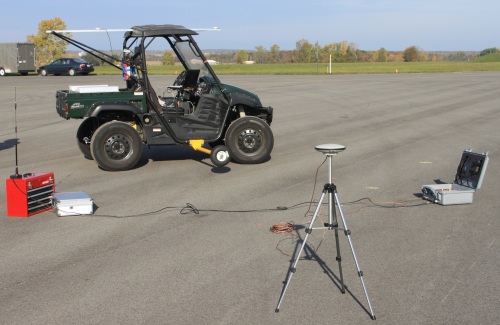A group of researchers have taken the unique approach of designing a concept car that is without an engine, transmission, and differential system. Instead, it relies on built-in electric battery-powered motors that control each wheel, thereby allowing it to make sharp turns and change directions very quickly.

All things considered, a car like that would be very difficult to drive. In fact, without a traction and motion control system, it would be downright dangerous.
But that’s where Junmin Wang comes in. He’s the assistant professor of mechanical engineering at Ohio State University, and he’s been tasked with developing algorithms for the vehicle’s onboard computer to ensure motion control that’ll keep the car stable and operating smoothly.
The system Wang’s working with receives and analyzes input data from the steering wheel, gas pedal, and brakes at a rate of approximately 100 times per second. Using this information, the computer figures out how each wheel should react.
“Without it, the car is quite difficult to drive because the wheels are not coordinated,” Wang explains on the National Science Foundation website. “You feel like you are driving something uncontrollable. You could flip over, or travel along an undesired path, or cause a crash. But when the 'controller' is active, based on feedback loops, the vehicle motion can be controlled, just as the driver expects.”
Specifically, the computer calculates how much torque the car needs for each of its wheels. Worth noting: since each wheel is independent from the others, one can be doing the braking while another is driving, giving the car an unprecedented amount of driving control.
“The computer gets signals from the driver from the steering wheel and pedal positions, then calculates the desired speed, or vehicle motion, based on a mathematical model,” Wang explains.
Some other interesting facts about this experimental vehicle:
• It weighs a little more than 1,750 pounds, making it much more energy efficient than today’s cars on the market.
• Each wheel has a 7.5 kW electric motor to it, and is powered by a 15 kW lithium-ion battery pack.
• Wang’s team retrofitted a commercially available utility terrain vehicle chassis to it and removed the engine, transmission and differential
• A single electrical cable connects the motors to a central computer.
• A car like this, that is, where each wheel has its own individual motor, is referred to as “four wheel independently actuated.”
During normal road testing, the car followed the driver’s “desired” path within 4 inches. On less than ideal surfaces, the car was able to maneuver with an accuracy of 8 inches, and the vehicle’s motion control system prevented “fishtailing” through independent control of the left and right sides of the car.
Exact mileage on a single charge hasn’t been figured out yet since the vehicle’s only been used in test-case scenarios. Wang did point out, though, that the car gets approximately 8 to 10 hours of driving on a single charge (not continuously).
The team believes their concept vehicle is still 5 to 10 years away from actual commercial use—computer algorithms still need some fine tuning, and more safety features need to be added to the vehicle. Once the system is worked out, it is believed this electric car will be the perfect in-city means of transportation, as it is both efficient and highly maneuverable in tight spaces, and emits no emissions either.
Story via: nsf.gov
Advertisement
Learn more about Electronic Products Magazine





